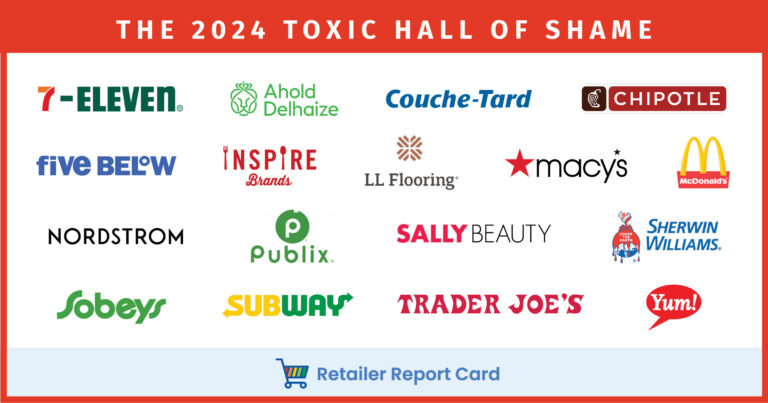PFAS “Forever Chemicals”
Want more? Sign up for our free updates!
What are PFAS “forever chemicals”?
PFAS, or per- and polyfluoroalkyl substances, have become notorious as drinking water contaminants as a result of industrial releases and use of firefighting foam. But chemical companies make and sell PFAS for a range of products, from stain-protection treatments for paper and textiles to non-stick coatings like Teflon, and our exposure comes from multiple sources.
Known as “forever chemicals” because of their remarkable persistence and mobility—they do not break down in the environment and can move through soil to contaminate drinking water—PFAS are global pollutants that threaten the health of people and wildlife.
How am I exposed to PFAS?
We are exposed to PFAS in food, from indoor air and dust, and in many cases, from drinking water. Food, air, and water have become contaminated globally as a result of manufacturing releases and use of PFAS-containing products.
- Indoor air and dust: When PFAS are used in products such as stain-proofing for furniture and carpets, or waterproofing for clothing, these items release the chemicals over time into air and dust.1
- Drinking water: Chemical plants making PFAS, product manufacturing plants, firefighting foam, landfills, and spreading of sludge have led to widespread contamination of drinking water in the U.S.2 Today, millions of U.S. residents are served by a drinking water source contaminated with PFAS.3
- Consumer and workplace products: PFAS use in cleaners, building materials, cosmetics, personal care products, and specialty products such as ski wax can lead to direct exposure from product use.4
- Food: PFAS can build up in crops, fish, and livestock, ultimately contaminating the food we eat. In addition, when PFAS are used in food packaging such as bags, sandwich wrappers, and takeout containers, they can migrate to our food.
Why should I be concerned?
PFAS are extremely persistent in the environment, and some of them build up in people and animals.5 They can migrate out of consumer products into household dust and air, are released by industries, and contaminate drinking water and food. Nearly all U.S. residents have PFAS in their bodies, with biomonitoring studies finding PFAS in blood, breast milk, umbilical cord blood, amniotic fluid, placenta, and other tissues.6
A growing body of scientific research has found links between PFAS exposure and a wide range of health problems including a weaker immune system, cancer, increased cholesterol levels, pregnancy-induced hypertension, liver damage, reduced fertility, and increased risk of thyroid disease.
- Harm to the immune system: Research has identified the immune system as sensitive to PFAS in both laboratory and epidemiological studies. A number of studies have found that children with higher exposure to PFAS have both poorer immune response to vaccines and more childhood infections.7
- Cancer: The International Agency for Research on Cancer has designated the common drinking water contaminant PFOA as a possible carcinogen, and a highly exposed population had a higher incidence of testicular and kidney cancer.8
- Cholesterol: Studies in people have linked PFAS exposure to higher cholesterol.9
- Thyroid effects: PFAS exposure has been linked to thyroid dysfunction and disease in both the general and highly exposed populations.7
- Liver toxicity: PFAS are associated with multiple effects on the liver including fatty liver and disruption of liver function.7
- Reproductive and toxicity: PFAS exposure is linked to pregnancy-induced hypertension as well as reduced birth weight.9
Which companies manufacture PFAS?
Companies that have reported use to the U.S. Environmental Protection Agency include Arkema, Asahi, BASF (Ciba), Clariant, Daikin, DuPont (PFAS business now under the name Chemours), Dyneon/3M, and Solvay.10
How can I reduce my exposure?
- We can reduce exposures for everyone by winning policies and market actions to replace PFAS with safer substitutes. You can let your favorite retailers, brands, as well as policymakers know that you want them to ban PFAS and make sure substitutes are safer.
- Avoid clothing, furniture, bedding, and other household items marketed as stain- and/or water-resistant. Instead, choose items that are washable. If you need apparel or home furnishings that are waterproof or water-resistant, find items that are PFAS-free. Contact companies and search for items listed as PFAS-free to ensure they are free of the entire class of compounds. Avoid any item with labeling such as “PFOA-free” that indicates it is free of some but not all PFAS.
- Stay away from greasy or oily packaged and fast foods, as the packages often contain grease-repellent coatings. Examples include microwave popcorn bags and some fast-food wrappers.
- Avoid personal-care products made with Teflon™ or containing ingredients that include the words “fluoro” or ”perfluoro.” PFAS can be found in dental floss and a variety of cosmetics, including foundation, lip products, and mascara.
- Avoid Teflon™ or non-stick cookware.
What’s the solution?
It is impossible for us to shop our way out of this problem. And we shouldn’t have to. When you walk into a store, you should be able to trust that the products on store shelves are safe.
Companies shouldn’t sell products with dangerous chemicals—especially as scientists continue to learn more about the “silent epidemic” caused by the cumulative impact of all the toxic chemicals we are regularly exposed to. And our state and federal governments shouldn’t allow chemicals on the market until they’re proven safe.
The only way to protect everyone from toxic chemicals like PFAS is to change policies at government and corporate levels to make sure that safer solutions are the norm.
We’re fighting every day to protect you and your loved ones from toxic chemicals like this. To join our fight, please consider making a donation, taking action with us, or signing up for our email list.
Healthy Choices
Take Action

Endnotes:
-
Schlummer, M.; Gruber, L.; Fiedler, D.; Kizlauskas, M.; Müller, J., Detection of fluorotelomer alcohols in indoor environments and their relevance for human exposure. Environ Int 2013, 57-58, (42-49).
-
Sunderland, E.; Hu, X.; Dassuncao, C.; Tokranov, A.; Wagner, C.; Allen, J., A review of the pathways of human exposure to poly- and perfluoroalkyl substances (PFASs) and present understanding of health effects. J Expo Sci Environ Epidemiol 2019, 29, (2), 131-147.
-
Hu, X.; Andrews, D.; Lindstrom, A.; Bruton, T.; Schaider, L.; Grandjean, P.; Lohmann, R.; Carignan, C.; Blum, A.; Balan, S.; Higgins, C.; Sunderland, E., Detection of poly- and perfluoroalkyl substances (PFASs) in U.S. drinking water linked to industrial sites, military fire training areas, and wastewater treatment plants. Environ Sci Technol Lett 2016, 3, 344-350.
-
Whitehead, H. D.; Venier, M.; Wu, Y.; Eastman, E.; Urbanik, S.; Diamond, M. L.; Shalin, A.; Schwartz-Narbonne, H.; Bruton, T. A.; Blum, A.; Wang, Z.; Green, M.; Tighe, M.; Wilkinson, J. T.; McGuinness, S.; Peaslee, G. F., Fluorinated Compounds in North American Cosmetics. Environmental Science & Technology Letters 2021, 8, (7), 538-544.
-
Wang, Z.; DeWitt, J.; Higgins, C.; Cousins, I. T., A never-ending story of per- and polyfluoroalkyl substances (PFASs)? Environ Sci Technol 2017, 51, 2508-2518.
-
Zheng, G.; Schreder, E.; Dempsey, J. C.; Uding, N.; Chu, V.; Andres, G.; Sathyanarayana, S.; Salamova, A., Per- and Polyfluoroalkyl Substances (PFAS) in Breast Milk: Concerning Trends for Current-Use PFAS. Environmental Science & Technology 2021, 55, (11), 7510-7520.
-
Fenton, S. E.; Ducatman, A.; Boobis, A.; DeWitt, J. C.; Lau, C.; Ng, C.; Smith, J. S.; Roberts, S. M., Per- and Polyfluoroalkyl Substance Toxicity and Human Health Review: Current State of Knowledge and Strategies for Informing Future Research. Environmental Toxicology and Chemistry 2021, 40, (3), 606-630.
-
Barry, V.; Winquist, A.; Steenland, K., Perfluorooctanoic Acid (PFOA) exposures and incident cancers among adults living near a chemical plant. Environ Health Perspect 2013, 121, (11-12), 1313-1318.
-
Agency for Toxic Substances & Disease Registry Toxicological Profile for Perfluoroalkyls; U.S. Department of Health and Human Services, Public Health Service: 2021.
-
US Environmental Protection Agency 2010/2015 PFOA Stewardship Program – 2014 Annual Progress Reports. https://www.epa.gov/assessing-and-managing-chemicals-under-tsca/20102015-pfoa-stewardship-program-2014-annual-progress




